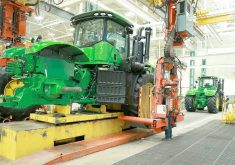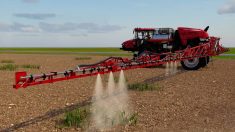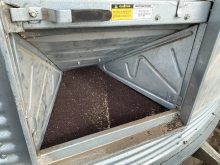The only change has been in how quickly the latest new support program has become useless in providing timely help.
One becomes somewhat pensive at this time of the year, reflecting on what happened during the past year and speculating on what might, or perhaps hope, will happen in the coming year. There is always the hope for good crops to be sold at high prices, but alas that is always subject to the whims of weather and crop disasters elsewhere in the world. The vision of growing crops for a fair return to feed everyone, including the starving teeming millions, will continue to be just an illusion.
Read Also

Farm equipment sales sector sees significant structural changes
Farming equipment sales have been declining for a number of years now, and one industry professional believes structural changes in the industry are needed to curb that trend.
Yet that possibility remains real, the sheer productive capacity of modern commercial agriculture, contrary to some urban media myths, would prove that we could adequately feed twice the human population of the Earth. However, commodity markets indicate that in general, surplus production remains a problem. Two years ago, there was media blathering about a food shortage and high prices (as if that is bad) and riots in the street. There were self-righteous comments about food crops being used for ethanol fuel production and how this nefarious new endeavour needed to be stopped. As we all knew, all it took was increased corn planting and an average harvest to return to business as usual.
I expect occasional food shortages will always be with us, but I note in some sectors food production reduction is the order of the day. Alberta livestock production is in the decline; dry weather, new trade barriers, low prices are all precipitating a decline in the cattle industry. The decline in the Alberta hog industry is reaching catastrophic proportions, some predict it will be down 50 per cent from its former peak. Livestock producer equity losses are beyond imagination. Only the lowly sheep industry seems to have any hope left.
Crop growers in most cases are holding their own over the past year, but there is some heartache. Sugar beet growers saw weather reduce production in a year that has seen the highest sugar prices in many years. But at least crop growers, particularly those with access to GM plants, can see incremental increases in yields and ongoing cost of production efficiencies.
Governments continue to show that political expediency has become their guiding light. At the federal level, Ottawa has continued steadfastly to stay true to its 40-year course of a revolving door of agriculture support. The only change has been in how quickly the latest new support program has become useless in providing timely help. AgriStability, AgriRecovery, AgriEtcetera have all become AgriVation to those that need it most. Politics has seen that an agriculture support program will always be necessary, and it seems bureaucratic scheming and bungling will see that a new and improved version of the latest failed program will be created every five years.
The past year in Alberta has seen ag politics sink to a new low with the agriculture minister vindictively destroying a producer organization. That action was somehow supposed to spur the cattle industry into political unity and a common industry development goal. I expect we will all be long gone before any of that happens, considering the deep animosity that has been created.
There is speculation that Premier Stelmach is planning a cabinet shuffle in the new year. We may well have a new ag minister as this edition arrives in your mailbox. There are those that wish that would happen, but don’t hold your breath. The Premier is also a farmer and a former ag minister and it is likely that he had a hand in the decisions taken by the present minister, including the checkoff termination. Moving or demoting the ag minister might question the wisdom of the Premier’s insight into appointing the present minister. Besides a new minister would need a lot guts to reverse any past department dubious decisions.
What the coming year may well bring is a deepening of the rural animosity towards the present PC government. A recent poll showed 44 per cent of rural voters favoured the surging Wildrose Alliance party, the governing PCs are a distant second. The last time there was such a massive change in rural voters’ attitude was 40 years ago when Peter Lougheed ousted the entrenched Social Credit party.
When voters are in economic turmoil, they begin to look for villains and saviours. It seems that has become infectious in rural Alberta if you include the devastation caused by the downturn in rural energy industry activity. Perhaps 2010 may be the year for the government to win or lose rural Alberta. You heard it here first.














